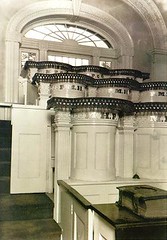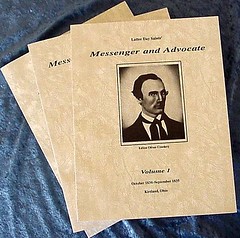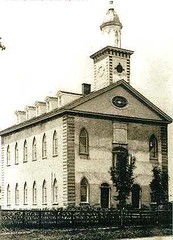A Church Of More Color
The Church expanding in Black and Hispanic neighborhoods:
Donte Holland, a 30-year-old carpenter’s apprentice, joined the Mormon church in Philadelphia two years ago because it gave him “the fruits of the spirit. Peace. A good feeling inside.”Holland and his wife, Rosalyn, are both black. The Mormon church is as white as its most famous members, Donny and Marie Osmond, and in Philadelphia, Eagles Coach Andy Reid. But for the last decade or so, the Mormons, officially known as the Church of Jesus Christ of Latter-day Saints, or LDS, have been expanding in city neighborhoods with large black and Spanish-speaking populations.
The Church's ethnic membership increases:
Recently, a new Mormon church building at Broad and Wyoming streets in Philadelphia held an open house with food and information about the church and about other topics, including medical care and financial planning. The Harlem and Philadelphia churches follow an earlier expansion in Detroit.
The church does not record members’ racial or ethnic backgrounds, but experts estimate that black Mormons number 5,000 to 10,000 in the United States, up from almost none 30 years ago.
The church says 130,000 people belong to its Spanish-speaking congregations, up from 92,600 in 1995.
The Broad and Wyoming location includes a Spanish-speaking service, and attendance at that has grown from 60 to about 110 since the new building opened earlier this year.
Growth tied to inner city work:
“There is a kind of changing face of the LDS church because of its continuing commitment to work in the inner cities,” said Melvyn Hammarberg, an associate professor of anthropology at the University of Pennsylvania who has studied the Mormons.
Despite past racial issues many Blacks call the Church home:
Despite the church’s history, several black members said only the Mormon church ever felt like home.
Ahmad S. Corbitt, who grew up in Philadelphia and graduated from John Bartram High School, got his Arab name from his parents, who were involved with the Nation of Islam and knew Malcolm X. The family later converted to the Methodist Church. But when Mormons knocked on his family’s door in South Jersey in 1980, “my mother felt a peaceful, spiritual feeling immediately.”
Black Church leadership a natural consequence:
After several years as a lawyer and public relations executive, he became director of the New York Office of Public and International Affairs of the church. Last month, he became Stake President for the Church in South Jersey, a promotion roughly equivalent to becoming a bishop in the Catholic Church. Corbitt, 43, is one of a handful of black stake presidents in the United States.
At one of the new Philadelphia church’s first services, the crowd of about 100 people appeared to be about 30 percent black. The surrounding neighborhood is about 80 percent black.
There have been a growing number of media stories about Church growth in the inner city, including this one, from the New York Sun about recent Church growth in Harlem; or, this, from the Detroit Free Press. I think this is a sleeper issue with great future impact for the Church worldwide, as well as the United States. The most significant, is the very real likelihood of a member of color in the Quorum of the Twelve and other governing Priesthood quorums in the future.







5 Comments:
The image in of the church in the States may be largely white, but with more members now outside the States than in, I doubt that we can really be counted as white.
True, taken in context of the world wide Church. The articles, to which I refer, however, are U.S. specific, and particularly inner city U.S. But, you make a good, and valid point. With more members outside the U.S., the Church as a whole is much more diverse. I should have clarifed my "white" reference or restricted it to within the United States. I'm happy, however, to see the Church become more active and involved in the inner cities in the U.S. Thanks for this reminder though.
I think its going to be another 20 or more years before a not-white member of the Twelve appears. The problem is two fold; the lifetime appointment of the calling and demographics of where the picked are living. Utah would have to change significantly or the leadership would have to go out of their way to reach well beyond traditional choice bounderies.
To be honest, I think its time for more (geographical and racial) diversity in the leadership. At the last general conference I had a personal vision of those on the podium speaking in their own language with English translations and voiceovers rather than choppy and thick accents. I don't think the Church will ever become "less American" because I believe that is the culture God has chosen to spread His Word. However, I do believe it will become far less White and European in more than just numbers.
(I'm the poster from #1, btw.)
> At the last general conference I had a personal vision of those on the podium speaking in their own language with English translations and voiceovers rather than choppy and thick accents.
What does language have to do with it? In today's world (granted it will probably change in the future) the most recognized language is English. It makes sense for speakers to use English when they are addressing a global church.
The use of translators only opens up a can of worms similar to "We believe the Bible to the the word of God as far as it is translated correctly."
I think the best thing is to have our leadership be multi-lingual and despite what I said above about English being the most recognized, I also think that multi-ligualism is a direcetion we're headed in, both as a church and as a global culture.
Sorry, I don't mean to spam but I keep forgetting to add my name to my posts. ^_^'
#1 and #4 are mine. :)
--harpingheather
Post a Comment
<< Home